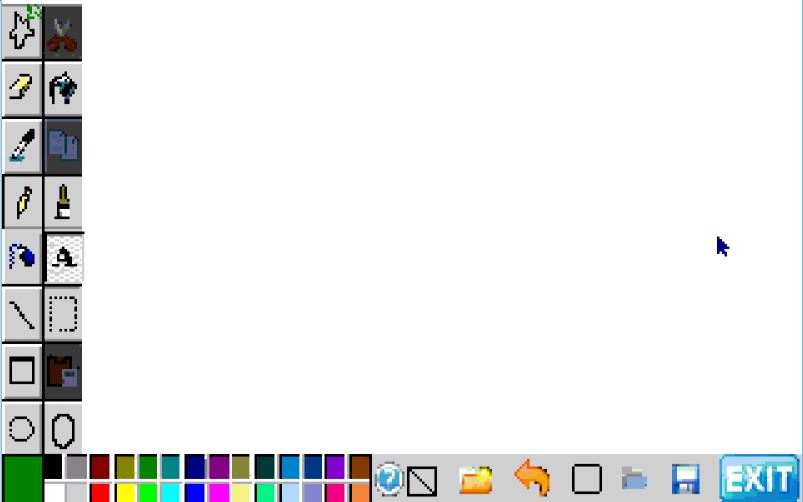I´m learning to do some low level VGA programming in DOS with C and inline assembly. Right now I´m trying to create a function that prints out a character on screen.
This is my code:
//This is the characters BITMAPS
uint8_t characters[464] = {
0x00,0x00,0x00,0x00,0x00,0x00,0x00,0x00,0x20,0x20,0x20,0x20,0x00,0x20,0x00,0x50,
0x50,0x00,0x00,0x00,0x00,0x00,0x50,0xf8,0x50,0x50,0xf8,0x50,0x00,0x20,0xf8,0xa0,
0xf8,0x28,0xf8,0x00,0xc8,0xd0,0x20,0x20,0x58,0x98,0x00,0x40,0xa0,0x40,0xa8,0x90,
0x68,0x00,0x20,0x40,0x00,0x00,0x00,0x00,0x00,0x20,0x40,0x40,0x40,0x40,0x20,0x00,
0x20,0x10,0x10,0x10,0x10,0x20,0x00,0x50,0x20,0xf8,0x20,0x50,0x00,0x00,0x20,0x20,
0xf8,0x20,0x20,0x00,0x00,0x00,0x00,0x00,0x60,0x20,0x40,0x00,0x00,0x00,0xf8,0x00,
0x00,0x00,0x00,0x00,0x00,0x00,0x00,0x60,0x60,0x00,0x00,0x08,0x10,0x20,0x40,0x80,
0x00,0x70,0x88,0x98,0xa8,0xc8,0x70,0x00,0x20,0x60,0x20,0x20,0x20,0x70,0x00,0x70,
0x88,0x08,0x70,0x80,0xf8,0x00,0xf8,0x10,0x30,0x08,0x88,0x70,0x00,0x20,0x40,0x90,
0x90,0xf8,0x10,0x00,0xf8,0x80,0xf0,0x08,0x88,0x70,0x00,0x70,0x80,0xf0,0x88,0x88,
0x70,0x00,0xf8,0x08,0x10,0x20,0x20,0x20,0x00,0x70,0x88,0x70,0x88,0x88,0x70,0x00,
0x70,0x88,0x88,0x78,0x08,0x70,0x00,0x30,0x30,0x00,0x00,0x30,0x30,0x00,0x30,0x30,
0x00,0x30,0x10,0x20,0x00,0x00,0x10,0x20,0x40,0x20,0x10,0x00,0x00,0xf8,0x00,0xf8,
0x00,0x00,0x00,0x00,0x20,0x10,0x08,0x10,0x20,0x00,0x70,0x88,0x10,0x20,0x00,0x20,
0x00,0x70,0x90,0xa8,0xb8,0x80,0x70,0x00,0x70,0x88,0x88,0xf8,0x88,0x88,0x00,0xf0,
0x88,0xf0,0x88,0x88,0xf0,0x00,0x70,0x88,0x80,0x80,0x88,0x70,0x00,0xe0,0x90,0x88,
0x88,0x90,0xe0,0x00,0xf8,0x80,0xf0,0x80,0x80,0xf8,0x00,0xf8,0x80,0xf0,0x80,0x80,
0x80,0x00,0x70,0x88,0x80,0x98,0x88,0x70,0x00,0x88,0x88,0xf8,0x88,0x88,0x88,0x00,
0x70,0x20,0x20,0x20,0x20,0x70,0x00,0x10,0x10,0x10,0x10,0x90,0x60,0x00,0x90,0xa0,
0xc0,0xa0,0x90,0x88,0x00,0x80,0x80,0x80,0x80,0x80,0xf8,0x00,0x88,0xd8,0xa8,0x88,
0x88,0x88,0x00,0x88,0xc8,0xa8,0x98,0x88,0x88,0x00,0x70,0x88,0x88,0x88,0x88,0x70,
0x00,0xf0,0x88,0x88,0xf0,0x80,0x80,0x00,0x70,0x88,0x88,0xa8,0x98,0x70,0x00,0xf0,
0x88,0x88,0xf0,0x90,0x88,0x00,0x70,0x80,0x70,0x08,0x88,0x70,0x00,0xf8,0x20,0x20,
0x20,0x20,0x20,0x00,0x88,0x88,0x88,0x88,0x88,0x70,0x00,0x88,0x88,0x88,0x88,0x50,
0x20,0x00,0x88,0x88,0x88,0xa8,0xa8,0x50,0x00,0x88,0x50,0x20,0x20,0x50,0x88,0x00,
0x88,0x50,0x20,0x20,0x20,0x20,0x00,0xf8,0x10,0x20,0x40,0x80,0xf8,0x00,0x60,0x40,
0x40,0x40,0x40,0x60,0x00,0x00,0x80,0x40,0x20,0x10,0x08,0x00,0x30,0x10,0x10,0x10,
0x10,0x30,0x00,0x20,0x50,0x88,0x00,0x00,0x00,0x00,0x00,0x00,0x00,0x00,0x00,0xf8,
0x00,0xf8,0xf8,0xf8,0xf8,0xf8,0xf8};
/**************************************************************************
* put_char *
* Print char *
**************************************************************************/
void put_char(int x ,int y,int ascii_char ,byte color){
__asm__(
"push %si\n\t"
"push %di\n\t"
"push %cx\n\t"
"mov color,%dl\n\t" //test color
"mov ascii_char,%al\n\t" //test char
"sub $32,%al\n\t"
"mov $7,%ah\n\t"
"mul %ah\n\t"
"lea $characters,%si\n\t"
"add %ax,%si\n\t"
"mov $7,%cl\n\t"
"0:\n\t"
"segCS %lodsb\n\t"
"mov $6,%ch\n\t"
"1:\n\t"
"shl $1,%al\n\t"
"jnc 2f\n\t"
"mov %dl,%ES:(%di)\n\t"
"2:\n\t"
"inc %di\n\t"
"dec %ch\n\t"
"jnz 1b\n\t"
"add $320-6,%di\n\t"
"dec %cl\n\t"
"jnz 0b\n\t"
"pop %cx\n\t"
"pop %di\n\t"
"pop %si\n\t"
"retn"
);
}
I´m guiding myself from this series of tutorials written in PASCAL: http://www.joco.homeserver.hu/vgalessons/lesson8.html .
I changed the assembly syntax according to the gcc compiler, but I´m still getting this errors:
Operand mismatch type for 'lea'
No such instruction 'segcs lodsb'
No such instruction 'retn'
EDIT:
I have been working on improving my code and at least now I see something on the screen. Here´s my updated code:
/**************************************************************************
* put_char *
* Print char *
**************************************************************************/
void put_char(int x,int y){
int char_offset;
int l,i,j,h,offset;
j,h,l,i=0;
offset = (y<<8) + (y<<6) + x;
__asm__(
"movl _VGA, %%ebx;" // VGA memory pointer
"addl %%ebx,%%edi;" //%di points to screen
"mov _ascii_char,%%al;"
"sub $32,%%al;"
"mov $7,%%ah;"
"mul %%ah;"
"lea _characters,%%si;"
"add %%ax,%%si;" //SI point to bitmap
"mov $7,%%cl;"
"0:;"
"lodsb %%cs:(%%si);" //load next byte of bitmap
"mov $6,%%ch;"
"1:;"
"shl $1,%%al;"
"jnc 2f;"
"movb %%dl,(%%edi);" //plot the pixel
"2:\n\t"
"incl %%edi;"
"dec %%ch;"
"jnz 1b;"
"addl $320-6,%%edi;"
"dec %%cl;"
"jnz 0b;"
: "=D" (offset)
: "d" (current_color)
);
}
If you see the image above I was trying to write the letter "S". The results are the green pixels that you see on the upper left side of the screen. No matter what x and y I give the functon it always plots the pixels on that same spot.
Can anyone help me correct my code?


uint8_t characters[464] = {could beuint8_t characters[] = {– Bumgarnerlea $characters,%simust not use the$, it's a memory reference.segcs lodsbshould probably belodsb %cs:(%si)and just useretinstead ofretn. – Heavyweightgjgppis an IDE, not a compiler. – Hesse(.text +0x454): Undefined reference to color(.text +0x459): Undefined reference to ascii_char(.text +0x466): Undefined reference to characters– Twisterascii_charsandcolorare function arguments you can't reference them by name like that.charactersis a global and should work, but might be mangled. Try to use_charactersinstead. PS: you shouldn't use inline function, use a separate module. Also maybe consider using a more recent environment ;) – Heavyweight(%bp)relative addressing and hope it works. As a hack, you could also declare global variables for them and assign to them in C before your asm code. – Heavyweighthttps://msdn.microsoft.com/en-us/library/windows/desktop/dd183370%28v=vs.85%29.aspx). What you're really doing is learning a historic API. – Teenyweeny